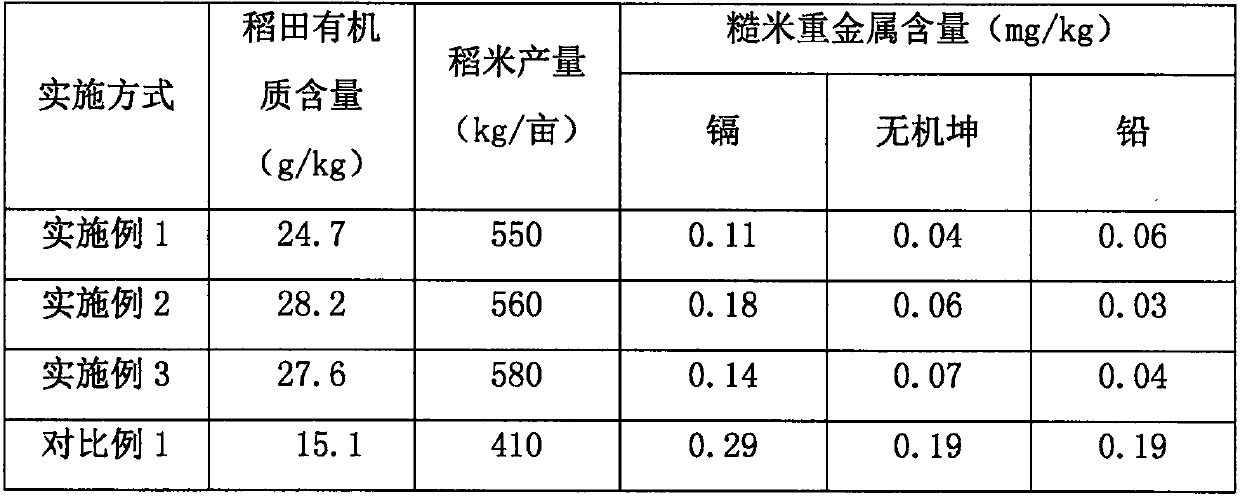Method for utilizing sweet potato starch acid slurry wastewater to improve paddy soil and reduce heavy metal content of rice
A technology of sweet potato starch and heavy metals, which is applied in the agricultural field, can solve problems such as unreported and insurmountable impacts, and achieve the effects of simple and easy operation, shortening the improvement cycle, and inhibiting absorption
- Summary
- Abstract
- Description
- Claims
- Application Information
AI Technical Summary
Problems solved by technology
Method used
Image
Examples
Embodiment 1
[0019] Embodiment one: utilize sweet potato starch Physalis wastewater to improve paddy field soil and reduce the method for rice heavy metal content, be in the following specific implementation steps:
[0020] (1) Wastewater improvement of soil: implemented in areas with heavy metal pollution in soil (arsenic 26.2mg / kg, cadmium 0.75mg / kg, lead 169.1mg / kg, pH value 7.2), Physalis wastewater and irrigation during sweet potato processing Water, wherein the pH value of the Physalis wastewater is 3.0, the Physalis wastewater and irrigation water are mixed to obtain the first mixed water, and the pH of the first mixed water is controlled to be 5.0; according to the soil pH range, the mixed water is used for the first time. Fill the soil once with water to adjust the pH of the soil to 6.0, let the water layer dry naturally, then put in organic fertilizer after 10 days of simmering, and then mix the soil and fertilizer evenly in the palladium field again to cultivate rice seedlings ....
Embodiment 2
[0023] Embodiment two: utilize sweet potato starch Physalis waste water to improve paddy field soil and reduce the method for rice heavy metal content, be in the following specific implementation steps:
[0024] (1) Wastewater improvement of soil: implement in areas polluted by heavy metals in soil (cadmium 0.75mg / kg, lead 169.1mg / kg, pH value 7.2), take physalis wastewater and irrigation water during sweet potato processing, of which physalis wastewater Physalis wastewater and irrigation water are mixed to obtain the first mixed water, and the pH of the first mixed water is controlled to be 5.5; according to the soil pH range, the mixed water is used to fill the soil once for the first time , so that the pH of the soil is adjusted to 6.9, let the water layer dry naturally, then put the organic fertilizer into the palladium field after 10 days of simmering, and then mix the soil and fertilizer evenly in the palladium field again to cultivate rice seedlings.
[0025] (2) Regula...
Embodiment 3
[0027] Embodiment three: utilize sweet potato starch Physalis waste water to improve paddy field soil and reduce the method for rice heavy metal content, be in the following specific implementation steps:
[0028] (1) Wastewater improvement of soil: implement in areas polluted by heavy metals in soil (cadmium 0.75mg / kg, lead 169.1mg / kg, pH value 7.2), take physalis wastewater and irrigation water during sweet potato processing, of which physalis wastewater Physalis wastewater and irrigation water are mixed to obtain the first mixed water, and the pH of the first mixed water is controlled to be 5.25; according to the soil pH range, the mixed water is used to fill the soil once for the first time , so that the pH of the soil is adjusted to 6.5, let the water layer dry naturally, then put in organic fertilizers in the palladium field after 10 days of simmering, and then mix the soil and fertilizer evenly in the palladium field again to cultivate rice seedlings.
[0029] (2) Regul...
PUM
 Login to View More
Login to View More Abstract
Description
Claims
Application Information
 Login to View More
Login to View More - R&D
- Intellectual Property
- Life Sciences
- Materials
- Tech Scout
- Unparalleled Data Quality
- Higher Quality Content
- 60% Fewer Hallucinations
Browse by: Latest US Patents, China's latest patents, Technical Efficacy Thesaurus, Application Domain, Technology Topic, Popular Technical Reports.
© 2025 PatSnap. All rights reserved.Legal|Privacy policy|Modern Slavery Act Transparency Statement|Sitemap|About US| Contact US: help@patsnap.com

